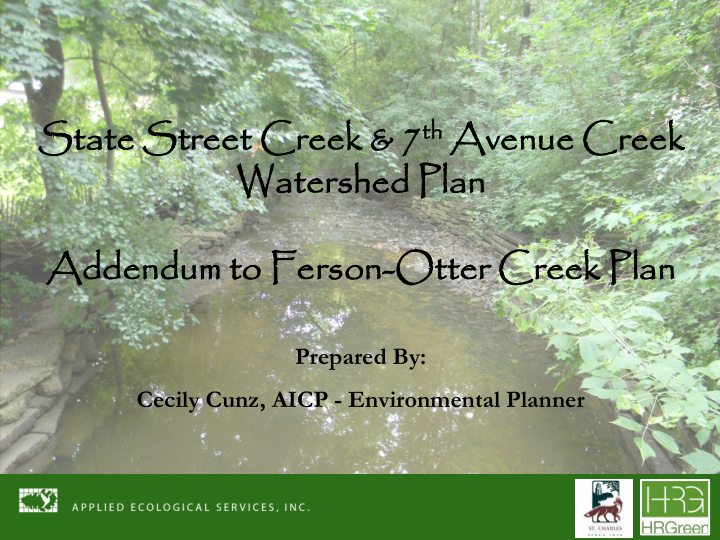



State te Street t Creek & 7 th th Avenue nue C Creek Waters tershed P d Plan n Addendum to to Ferson-Otte Otter C Creek Plan Prepared By: Cecily Cunz, AICP - Environmental Planner
Agend enda • Review of last meeting and follow-up • Water Quality • Pollutant Loading Model • Causes & Sources of Impairments • Critical Areas • Action Plan o Programmatic o Site Specific
Last M Meet eeting ng F Follo llow-up up • Last meeting: Watershed Inventory and Assessment • Followed up on possible water quality data available through Fox River Study Group database or EPA STORET – no other data available • Changed Hunt Club wetland from wetland to detention in the data • Received groundwater well data from the City and incorporated into groundwater section • Addressed coal tar sealants in Programmatic Recommendations • Received water quality data at WWTP from the City
Water ter Qua uality Neither stream assessed by IEPA No pre-existing sampling data found AES conducted water quality sampling twice: October 7 th , 2016 after a 0.5” rain event • 7 th Avenue Creek October 26 th , 2016 after a 1+” rain event • Both streams are very flashy! 7 th Avenue Creek State Street Creek
Water ter Qua uality Water quality sampling results: State Street & 7 th Avenue Creek Impaired for nitrogen , phosphorus , and total • suspended solids State Street Creek Buried streams result in higher nitrogen levels •
Water ter Qua uality
Polluta utant nt Loadi ding ng M Model USEPA’s Spreadsheet Tool to Estimate Pollutant Loads (STEPL) Inputs by Subwatershed Management Unit: Land Use/Land Cover Categories • Precipitation • Soils Information • Existing Streambank Conditions • Existing best management practices • Other data •
Polluta utant nt Loadi ding ng M Model Modeling results: 93% of all pollutants stem from Urban sources • All remaining sources less than 5% •
Hot Hot Sp Spot ot SM SMUs
Reduc eduction Target ets
Cause ses & & Sou Sources of of Im Impairment
Crit Critical A Are reas Four critical area types: 15 Highly degraded stream reaches and riparian areas • 27 Detention basin retrofits • 13 Urban and other management measures • o 4 Swale retrofits o 5 Turf/park retrofits o 3 Woodland restoration/management o 1 Parking lot retrofit o 1 Brownfield redevelopment 131 acres of green infrastructure protection areas •
Crit Critical A Are reas
Action on P Plan Compo ponents Programmatic Measures: general remedial, preventive, and policy watershed-wide Management Measures that can be applied across the watershed by various stakeholders. Site Specific Measures: actual locations where Management Measure projects can be implemented to improve surface and groundwater quality, green infrastructure, and flooding. Source: Integrated Lakes Management, Inc.
Policy R cy Recommenda datio ions Plan Adoption & Implementation • Green Infrastructure Network • Groundwater Protections • Sensible (Road) Salting Recommendations • Lawn Fertilizer • Stormwater Management • Native Landscaping/Natural Area Restoration • Pavement Alternatives •
Stream & & Riparian A Area ea Res estoration n Restoration: Improve stream channel using artificial pool- riffle complexes, streambank stabilization using a combination of bioengineering with native vegetation and hard armoring with rock if need
Detenti tion on D Desi sign gn, , Retrofi ofits, E ts, Esta tablish shme ment, t, & Maintena nanc nce Location • Design • Short & Long Term Native • Vegetation Establishment
Vegetated S Swales ( (Bioswal ales) Designed to infiltrate • stormwater and remove pollutants Aesthetically pleasing • Used to replace pipes • or curbs
Nat atur ural al A Are rea a Rest stora ration & Nativ ive L Landsca capin ing Transforming large scale open areas into ones that • exhibits better ecological health Using native plants at a smaller scale around homes • and businesses National Wildlife Federation’s Certified Wildlife • Habitat Program; Conservation Foundation’s Conservation@Home Program; Audubon Cooperative Sanctuary Program
• Pervious concrete Pav Pavement Alt lter ernatives • Permeable asphalt • Paver systems Allows for increased infiltration • to groundwater Can be used for parking lots, • parking aprons, private roads, fire lanes, residential driveways, and bike paths All are suitable alternatives to • coal-tar sealants Additionally, can ban the sale or • use of coal-tar sealants
Rainw nwater er H Harvesting ng & & Re-use use Downspout disconnection • Reduction in stormwater • runoff Utilizes rain barrels or cisterns • Most commonly used for • irrigation
Rain G n Gardens ns Small shallow depression planted with deep rooted native wetland vegetation
Street S Sweeping Removes • pollutants from roadways before they can enter streams Bi-weekly street • sweeping is shown to provide sufficient results
Green I een Inf nfrastructure P e Pla lann nning * Green Infrastructure preservation and planning is the key to achieving watershed health Protect specific unprotected green infrastructure parcels • through acquisition, regulation, and/or incentives. Incorporate conservation or low impact design standards on • green infrastructure parcels where development is planned. Limit future subdivision of green infrastructure parcels. • Implement long term management of green infrastructure. • 3186 Hughes Ct 120 W. Main St Dubuque, IA 52003 West Dundee, IL 60118
Site S e Spec ecific Mana nagement nt M Mea easures Streambank, Channel, & Riparian Area Restoration • Detention Basin Retrofits & Maintenance • Urban and Other Management Measures • Green Infrastructure Protection Areas •
Stream & am & Ripar arian an R Recomme mmendat ations 23 total recommendations 15 of those are critical areas * 83% of the total nitrogen and virtually 100% of total phosphorus and sediment reduction needs
Deten Detention Ba Basin R n Retr etrofit R Rec ecommenda dations ns 68 total recommendations 27 of those are critical areas
Urban n & Other Management nt Measur ures 26 total recommendations 13 of those are critical areas
Green n Infrastr truc uctur ture Prote tecti tion n Areas 57 acres in State St Creek & 74 acres in 7 th Avenue Creek
Que uestions? ons?
Recommend
More recommend